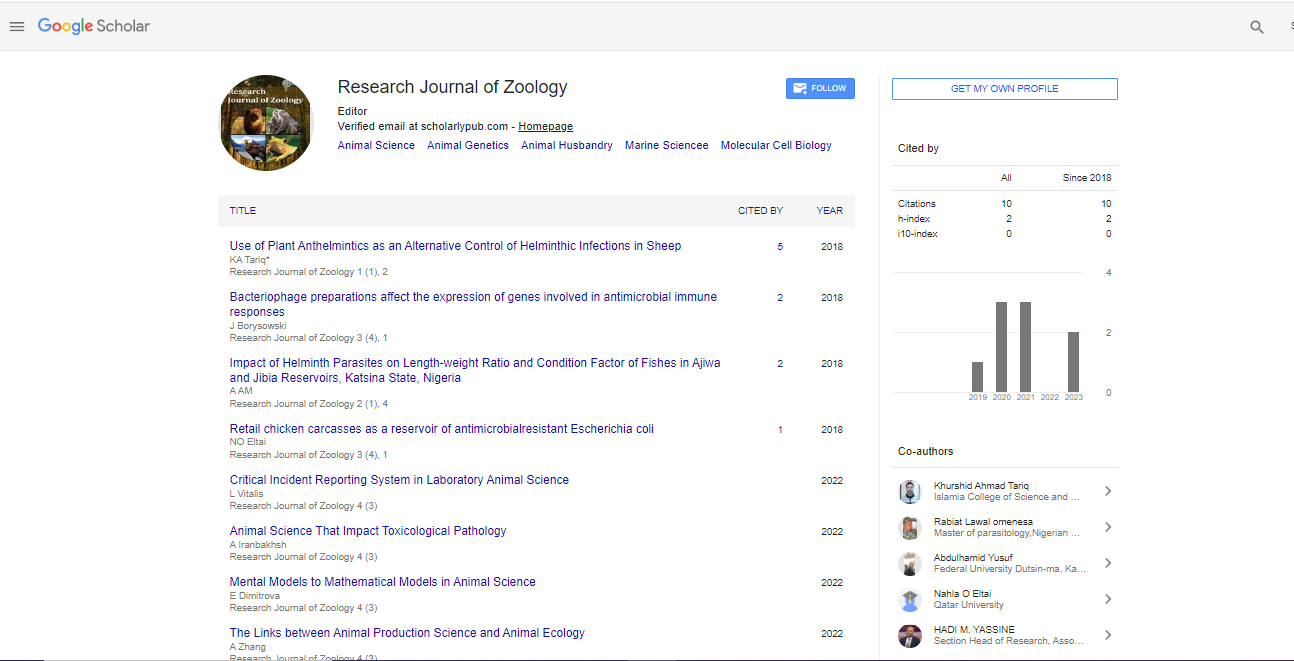Commentary, Res J Zool Vol: 5 Issue: 2
Uncovering the Ecological Role of Keystone Species in Coral Reef Ecosystems
Earl Bender*
1Department of Conservation Zoology, London School of Science and Management, London, United Kingdom
*Corresponding Author: Earl Bender,
Department of Conservation Zoology,
London School of Science and Management, London, United Kingdom
E-mail: benderearl@lji.uk
Received date: 30 August, 2023, Manuscript No. RJZ-23-118077;
Editor assigned date: 01 September, 2023, PreQC No. RJZ-23-118077 (PQ);
Reviewed date: 15 September, 2023, QC No. RJZ-23-118077;
Revised date: 22 September, 2023, Manuscript No. RJZ-23-118077 (R);
Published date: 29 September, 2023, DOI: 10.4172/rjz.1000085.
Citation: Bender E (2023) Uncovering the Ecological Role of Keystone Species in Coral Reef Ecosystems. Res J Zool 5:2.
Description
Coral reefs are often referred to as the rainforests of the sea due to their unparalleled biodiversity and complex interactions among various species. Within these diverse ecosystems, certain species play a pivotal role in maintaining the balance and health of the entire community. These species are known as keystone species. Uncovering the ecological role of keystone species in coral reef ecosystems is a crucial area of research, as it provides insights into the delicate web of interactions that sustains these vibrant and vital ecosystems. Keystone species are those that have a disproportionately large impact on their environment, considering their abundance or biomass. In coral reef ecosystems, these species are often predators, herbivores, or engineers, and they exert a profound influence on the composition and structure of the community. By understanding their ecological roles, scientists can develop more effective conservation and management strategies for protecting these fragile ecosystems. One of the most well-known examples of a keystone species in coral reefs is the parrotfish. Parrotfish are herbivores that graze on algae covering the coral. By doing so, they prevent the overgrowth of algae, which can smother corals and inhibit their growth. Parrotfish also contribute to the creation of coral sand, as they grind up coral a skeleton while feeding, which helps to form the sandy substrate of the reef. Their role as algae grazers and sand producers is vital to the health and resilience of coral ecosystems.
Another keystone species in coral reefs is the sea otter. While sea otters are not typically associated with tropical coral reefs, their presence in kelp forests along the Pacific Coast of North America has important implications for understanding keystone species. Sea otters feed on sea urchins, which are herbivores that graze on kelp. When sea otters are present, they keep sea urchin populations in check, allowing kelp forests to thrive. However, in the absence of sea otters, sea urchin populations can explode and decimate kelp forests, which are essential habitats for many marine species. This ripple effect highlights the critical role of predators in maintaining the balance of ecosystems.
Beyond herbivores and predators, engineers can also be keystone species in coral reef ecosystems. For instance, the branching corals themselves can be considered keystone engineers. The complex structures created by corals provide shelter and breeding grounds for numerous reef organisms, including fish and invertebrates. Additionally, the nooks and crannies of the coral branches offer protection from strong currents and predators, making them important habitat providers in these ecosystems. When coral populations decline due to factors like coral bleaching and ocean acidification, the entire ecosystem suffers as a result.
Understanding the ecological roles of keystone species is a multifaceted endeavor that involves a combination of field observations, experiments, and advanced technology. Researchers track the behaviors of these species, such as their foraging patterns and the effects of their presence or absence on the ecosystem. They also use tools like underwater cameras and remote sensing to monitor changes in coral reef dynamics. Furthermore, with the increasing threats to coral reefs, such as climate change, overfishing, and pollution, the role of keystone species becomes even more critical. For instance, rising ocean temperatures and ocean acidification can weaken corals, making them more vulnerable to disease. In such circumstances, the herbivores that keep algae in check, like parrotfish, become even more essential for coral survival. Conservation efforts often target these keystone species to protect coral reef ecosystems. Implementing marine protected areas, regulating fishing practices, and reducing pollution can help ensure the presence and stability of keystone species. Scientists and conservationists are also working on coral restoration initiatives, such as coral gardening, to rebuild damaged reefs and bolster the populations of engineer species like corals.
In conclusion, the study of keystone species in coral reef ecosystems is of paramount importance for understanding and preserving these fragile marine communities. Whether they are herbivores, predators, or engineers, these species play critical roles in shaping the balance of these ecosystems. By unraveling their ecological significance and the intricate web of interactions they maintain, researchers and conservationists can develop strategies to protect and restore coral reefs, ensuring their continued vitality in the face of global environmental challenges. As coral reefs face mounting threats, the conservation of keystone species remains a linchpin in safeguarding these magnificent and invaluable marine ecosystems.
 Spanish
Spanish  Chinese
Chinese  Russian
Russian  German
German  French
French  Japanese
Japanese  Portuguese
Portuguese  Hindi
Hindi 
